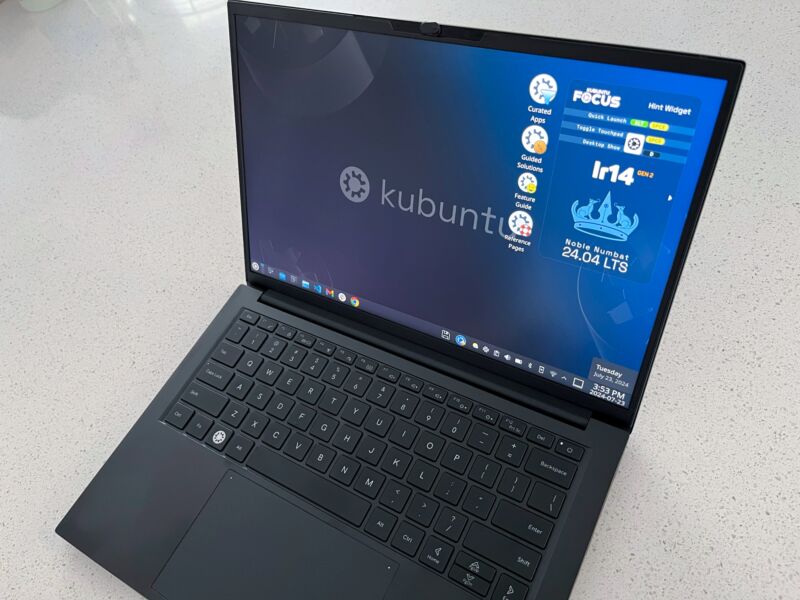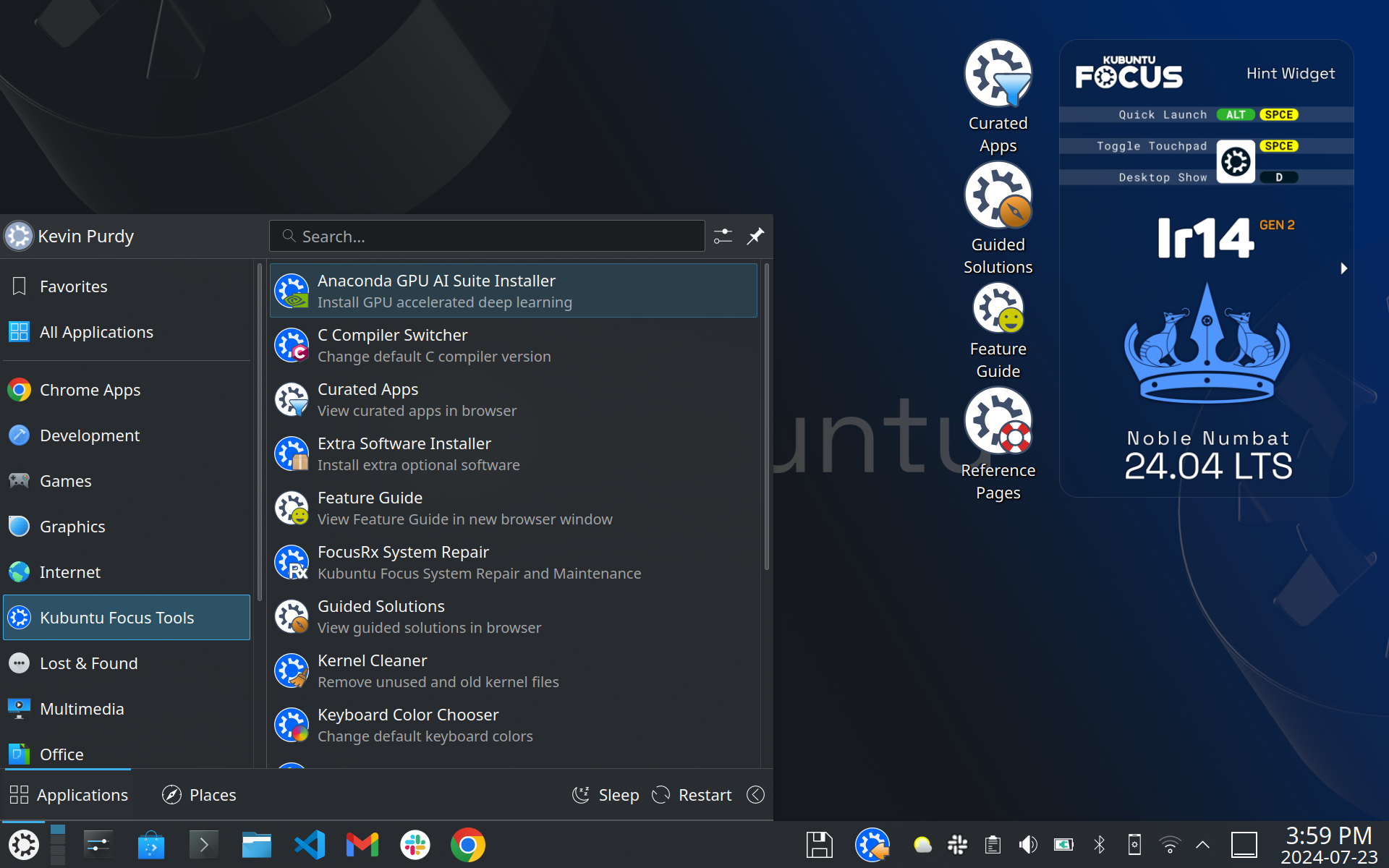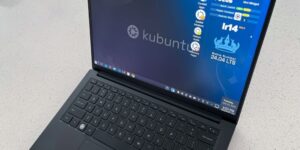
Kevin Purdy
There are lots of laptops—maybe all of them—on which you can run a Linux desktop. There are a few vendors that offer laptops with extensive Linux compatibility. And then there are a select few that specialize in Linux laptops, support them, and even customize them.
Kubuntu Focus is one of the select few. It sent me one of its laptops to test the Ir14 Gen 2, which runs, of course, Kubuntu, the KDE desktop variant of Ubuntu. The “Focus” in the company name comes from what it is hoping to provide: a device on which you can just do your work without worrying about what’s happening deeper in your system. Go ahead and sudo apt update, says the Focus team; we’ve got you.
I used the Ir14 Gen 2 for Ars Technica work and my personal needs for at least two weeks. Setting the system up with Focus’ guided wizard, installing apps from its store, and refusing to touch any of the deeper system files, I achieved something pretty remarkable: no unexpected behaviors on a Linux laptop. Had anything gone wrong, I could reasonably lean back on the system’s rollbacks, which I used a couple of times with no problem.
Is this what it could be like? Does using Linux on the desktop not have to involve compiling from source, searching for that one relevant forum comment related to a problem, wondering where the fault lies along the chain from kernel to desktop to repository to me? Maybe. Can you surrender a bit of your upgrade and tinkering curiosity in exchange for knowing that things will work when they get to you? It might be trickier than you think.
What is a Kubuntu Focus laptop, exactly?
A Kubuntu Focus Ir14 Gen 2 laptop includes these things:
- A laptop made by Carbon Systems, which supplies a lot of fleet and enterprise systems, and happens to make them relatively upgrade and repair-friendly
- A stock Kubuntu 24.04 LTS system with a Plasma desktop, with Focus’ integrations built in
- A few software tools from Focus, including power profiles and rollback
The Focus is not meant to let you do whatever you want but to keep doing what you do. Researchers, developers, and jet propulsion labs are some of Focus’ customers. Focus tests everything that will arrive on official update channels to the device. When kernel updates appear in the upstream, Focus makes sure everything on the device works with it, while also contributing back to Ubuntu, Kubuntu, KDE, and the kernel itself.
You don’t get interim releases. You don’t get staff in the forums helping you with running Arch or Fedora. There’s no custom desktop environment or windowing system (“We felt building a separate distribution and ecosystem is the last thing anyone needed,” the company writes). Focus chose reliability for daily-driver devices running Linux. It can, in other words, save you from yourself, if you’re a lot like me.
Besides testing, Focus also makes a bunch of tweaks to the system before shipping: some keyboard shortcuts, screen scaling and console font alterations, automatic power profiles on plug and unplug, and the like. Focus has also written up almost every corner of your system you want help on; you can check it out on its site.
-
The Kubuntu Focus Ir14 Gen 2.
Kevin Purdy -
A bit closer up on the trackpad and keyboard.
Kevin Purdy -
Ports on the left side of the Ir14 Gen 2.
Kevin Purdy -
Ports on the right side. You will not suffer from a USB-A deficiency on this one.
Kevin Purdy -
Lid closed. The chassis is a fingerprint magnet, like just about every black magnesium alloy laptop out there.
Kevin Purdy
The physical laptop
| Specs at a glance: Kubuntu Focus Ir14 Gen 2 | |
|---|---|
| Display | 14-inch IPS panel: 1920×1200 (16:10), 60 Hz, 350cd/m², 1,200:1 max contrast, 145-degree open angle |
| OS | Kubuntu 24.04 |
| CPU | Intel Core i5-13500H (4.7 GHz turbo, 12 cores, 18MB cache) |
| RAM | 16 GB DDR5-4800 (as reviewed), up to 96GB DDR5-5200 |
| GPU | Intel Iris Xe (80 execution units, 1.45 GHz) |
| Storage | 2 x M.2 2280 NVMe PCIe 4×4 (500GB as reviewed) |
| Networking | Intel Wi-Fi 6AX 201, Dual-mode Bluetooth 5.2 |
| Power/Battery | 53 WHr battery, 90-minute fast charge (90 W barrel or 100 W USB-C), 5-8 hours battery |
| Ports |
|
| Size | 12.4×8.6×0.7 in (315× 218×18 mm) |
| Weight | 3 lbs (1.36 kg) |
| Price as reviewed | $1,080 |
There’s not much to say about the hardware experience of the Ir14 Gen 2. The look and feel screams “fleet,” though a bit lighter and sleeker than the ThinkPads and HP Somethings of that realm. It weighs 3 pounds, the chassis is magnesium alloy, and the screen is a matte 14-inch FHD panel. The webcam is a 2 MP 1080p model, and you look about as bad as on every other laptop. The keyboard is backlit, and the Super/Win key is a little Kubuntu icon, which is cute.
Inside is an Intel Core i5-13500H Raptor Lake chip, and you can pack in up to 96GB of DDR5-5200 memory. Packing it in is easy, too, as this laptop is easy as heck to open, upgrade, and fix. You can slot up to two M.2 NVMe SSDs inside (PCIe 4.0 x 4) (at the starting price of $1,080, you get 500GB storage and 16GB RAM). And the port selection is quite good: A full-size HDMI 2.1, Thunderbolt 4, USB 3.2 Gen 2 Type-C, two (2!) USB 3.1 Type-A ports, a stereo jack, and a microSD card reader.
The most notable feature on any non-Apple laptop I test, the trackpad, gets a solid 7/10 from me. I could almost imagine using it in tap-to-click mode, but a few errant clicks and painful box selections led me back to my default click-to-click setting. I wondered if there were more settings available than the relatively few I saw, checked the help docs, and, yes, of course: Focus explained its choice of using Libinput by default instead of Synaptics touchpad tools. Neither one really got me to where I was totally comfortable with tap-to-click on that pad, but sparing me from the what-if rabbit hole is a value add.
The other two hardware notes: The webcam has a built-in privacy cover, but it’s a fussy little flap that I found hard to move around on my unit; the keyboard was responsive, had decent depth, and was both labeled clearly and backlit. It’s a perfectly cromulent portal to the software, which is what really matters here.

The Kubuntu Focus desktop on the Ir14 Gen 2.
Ars Technica




